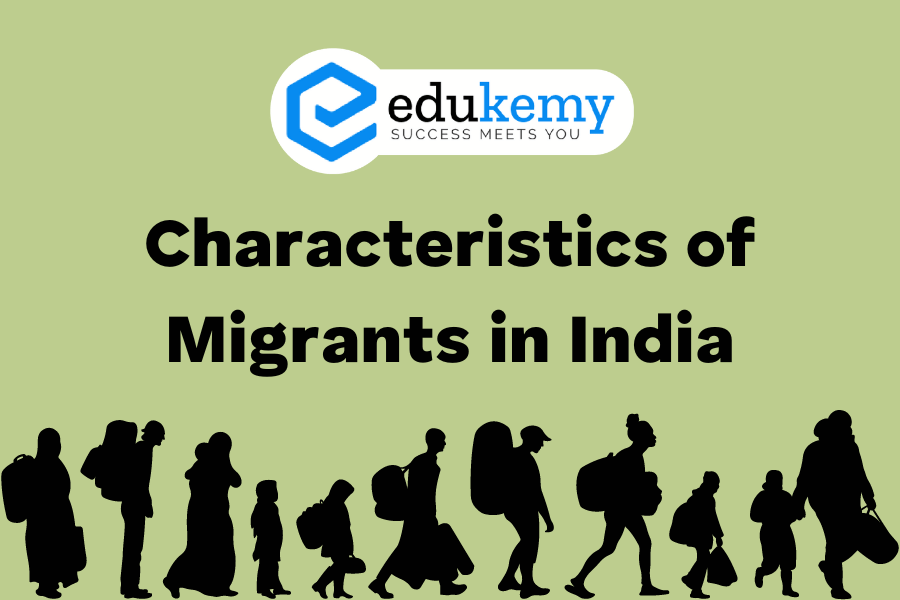
Migrants in India exhibit a diverse array of characteristics shaped by various factors such as socioeconomic status, education level, and regional disparities. Firstly, a significant portion of migrants originates from rural areas, driven by the search for better economic opportunities in urban centers. These migrants often belong to marginalized communities and lower-income strata, seeking employment in construction, agriculture, manufacturing, and service sectors. Moreover, there’s a notable gender dimension, with a considerable number of female migrants engaging in domestic work or informal sectors. Education levels among migrants vary widely, with some possessing higher education qualifications, migrating for skilled jobs, while others may have limited formal education, resorting to unskilled labor. Regional disparities within India also influence migration patterns, with individuals from states with fewer economic prospects often migrating to more prosperous regions. Additionally, age plays a crucial role, with young adults comprising a significant portion of migrants, seeking employment opportunities to support themselves and their families back home. Despite their diverse backgrounds, migrants collectively contribute to the dynamics of India’s labor force and urbanization, reflecting the country’s complex socio-economic landscape.
There are some important characteristics of the migrants and migration.
- An important characteristic is the age selectivity of the migrants. Generally, young people are more mobile.Most migration studies, especially in developing countries, have found that rural-urban migrants are predominantly young adults. It is obvious that migration for employment takes place mostly at the young adult ages.
- Also a major part of the female migration consequential to marriage occurs at the young adult ages. The female migration in India is largely sequential to marriage, because it is a Hindu custom to take brides from another village (village exogamy).
- Thus people have a tendency to move when they are between their teens and their mid-thirties (15-35 years) than at other ages.
- Another important characteristic is that the migrants have a tendency to move to those places where they have contacts and where the previous migrants serve as links for the new migrants, and this chain is thus formed in the process, and is usually called chain migration.
- They usually have kinship chains and networks of relatives and friends who help them in different ways. In some cases, the migrants not only tend to have the same destination but also tend to have the same occupation.
- For example, in certain hotels in Jaipur almost all the workers belong to one particular sub-region of Kumaon. The agricultural labourers in Punjab and Haryana are mainly from Bihar and Eastern Uttar Pradesh.
- The male migrants from rural to urban and urban to urban, employment were the most important reason. Education accounted only for about 3 to 8 percent of migration according to these migration streams.
- Among women, as expected, marriage was the most important reason for migration, followed by associational migration. Employment and education accounted for a very small proportion of the females.
Contents
- 1 FAQs
- 1.1 1. What are the main reasons for migration in India?
- 1.2 2. What are the key characteristics of internal migrants in India?
- 1.3 3. How does migration affect the demographic composition of Indian cities?
- 1.4 4. What challenges do migrants face in India?
- 1.5 5. How does internal migration contribute to the economy of India?
- 2 In case you still have your doubts, contact us on 9811333901.
FAQs
1. What are the main reasons for migration in India?
- Migrants in India are primarily driven by economic opportunities, seeking better employment prospects and higher wages. Other significant factors include education, marriage, family reasons, and escape from conflicts or natural disasters.
2. What are the key characteristics of internal migrants in India?
- Internal migrants in India often originate from rural areas and migrate to urban centers or other regions within the country. They exhibit diverse socio-economic backgrounds, with varying levels of education and skills. Seasonal migration for agricultural work is common, alongside permanent relocation for employment in sectors such as construction, manufacturing, and services.
3. How does migration affect the demographic composition of Indian cities?
- Migration contributes to the urbanization of Indian cities, leading to population growth and demographic changes. Cities experience cultural diversity due to migrants from different regions, languages, and ethnicities. Migration also impacts infrastructure, housing, healthcare, and education services in urban areas.
4. What challenges do migrants face in India?
- Migrants in India encounter numerous challenges, including inadequate housing, lack of access to healthcare and education, exploitation in the informal sector, social exclusion, and discrimination. They often face difficulties in accessing government welfare schemes and legal protections, leading to vulnerability and marginalization.
5. How does internal migration contribute to the economy of India?
- Internal migration is a significant driver of economic growth in India, as it fills labor shortages in various sectors and regions. Migrants contribute to agricultural productivity, urban development, construction, and service industries. Remittances sent by migrants to their families in rural areas also play a crucial role in poverty alleviation and rural development.
In case you still have your doubts, contact us on 9811333901.
For UPSC Prelims Resources, Click here
For Daily Updates and Study Material:
Join our Telegram Channel – Edukemy for IAS
- 1. Learn through Videos – here
- 2. Be Exam Ready by Practicing Daily MCQs – here
- 3. Daily Newsletter – Get all your Current Affairs Covered – here
- 4. Mains Answer Writing Practice – here

